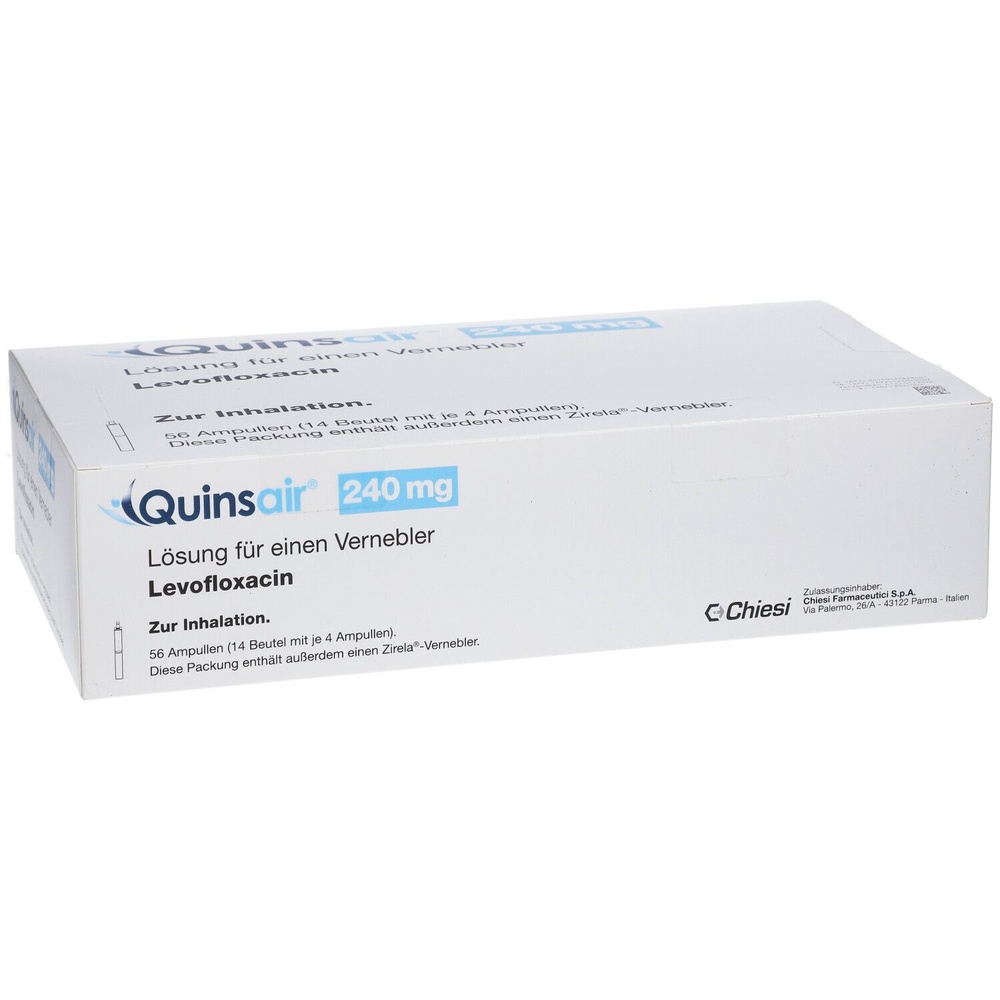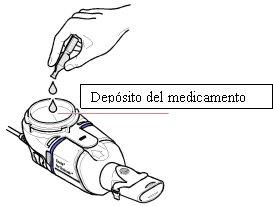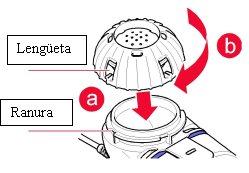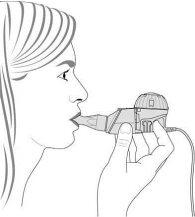

КВИНСАИР 240 мг РАСТВОР ДЛЯ ИНГАЛЯЦИЙ ЧЕРЕЗ НЕБУЛАЙЗЕР


Инструкция по применению КВИНСАИР 240 мг РАСТВОР ДЛЯ ИНГАЛЯЦИЙ ЧЕРЕЗ НЕБУЛАЙЗЕР
Введение
Инструкция: информация для пациента
Квинсайр 240мг раствор для ингаляции с помощью небулайзера
левофлоксацин
Прочитайте внимательно всю инструкцию перед началом использования этого препарата, поскольку она содержит важную информацию для вас.
- Сохраните эту инструкцию, поскольку вам может потребоваться перечитать ее.
- Если у вас есть какие-либо вопросы, проконсультируйтесь с вашим врачом или фармацевтом.
- Этот препарат был назначен вам, и не передавайте его другим людям, даже если они имеют те же симптомы, что и вы, поскольку это может нанести им вред.
- Если вы испытываете побочные эффекты, проконсультируйтесь с вашим врачом или фармацевтом, даже если это побочные эффекты, которые не указаны в этой инструкции. См. раздел 4.
Содержание инструкции
- Что такое Квинсайр и для чего он используется
- Что вам нужно знать перед началом использования Квинсайра
- Как использовать Квинсайр
- Возможные побочные эффекты
- Хранение Квинсайра
- Содержание упаковки и дополнительная информация
1. Что такое Квинсайр и для чего он используется
Квинсайр содержит антибиотическое лекарство под названием левофлоксацин. Он принадлежит к группе антибиотиков, называемых фторхинолонами.
Квинсайр используется для лечения инфекций легких, вызванных Pseudomonasaeruginosaу взрослых с муковисцидозом. Это антибиотик, который вдыхается (ингаляция) непосредственно в легкие, где убивает бактерии, вызывающие инфекцию. Это помогает улучшить дыхание у людей с муковисцидозом.
2. Что вам нужно знать перед началом использования Квинсайра
Не используйте Квинсайр:
- если вы аллергичнык левофлоксацинуили к любому другому антибиотику хинолоновой группы, такому как моксифлоксацин, ципрофлоксацин или офлоксацин, или к любому другому компоненту этого препарата (перечисленному в разделе 6)
- если у вас когда-либо были проблемы с сухожилиями(воспалениеили разрыв сухожилия) во время лечения антибиотиками хинолоновой или фторхинолоновой группы
- если у вас есть эпилепсия
- если вы беременныили кормите грудью
Предостережения и меры предосторожности
Перед началом приема этого препарата
Не принимайте антибактериальные препараты, содержащие фторхинолоны или хинолоны, включая Квинсайр, если вы ранее испытывали тяжелые побочные эффекты при приеме хинолонов или фторхинолонов. Если это произошло, сообщите об этом вашему врачу как можно скорее.
Во время лечения этим препаратом
В редких случаях могут возникать боль и отек в суставах, а также воспаление или разрыв сухожилий. Риск выше, если вы старше 60 лет, перенесли трансплантацию органа, имеете проблемы с почками или принимаете кортикостероиды. Воспаление и разрыв сухожилий могут возникнуть в течение первых 48 часов лечения или даже через несколько месяцев после прекращения лечения Квинсайром. При первых признаках боли или воспаления сухожилия (например, в области лодыжки, запястья, локтя, плеча или колена) прекратите принимать Квинсайр, свяжитесь с вашим врачом и обеспечьте покой пораженной области. Избегайте ненужных физических упражнений, поскольку они могут увеличить риск разрыва сухожилия.
Сообщите вашему врачу перед началом использования Квинсайра
если у вас есть или были следующие заболевания:
- Тяжелые побочные эффекты длительного действия, которые могут быть инвалидизирующими и потенциально необратимыми
Антибактериальные препараты, содержащие фторхинолоны или хинолоны, включая Квинсайр, могут быть связаны с очень редкими, но тяжелыми побочными эффектами, некоторые из которых могут быть длительными (продолжающимися месяцами или годами), инвалидизирующими или потенциально необратимыми. Это включает боль в сухожилиях, мышцах и суставах верхних и нижних конечностей, трудности при ходьбе, аномальные ощущения, такие как покалывание, онемение, жжение, ползание или зуд (парестезия), нарушения чувствительности, такие как снижение зрения, вкуса, обоняния и слуха, депрессия, снижение памяти и концентрации, сильная усталость и тяжелые нарушения сна.
Если вы испытываете любой из этих побочных эффектов после приема Квинсайра, немедленно свяжитесь с вашим врачом перед продолжением лечения. Вы и ваш врач решите, продолжать ли лечение или нет, учитывая также использование антибиотика другой группы.
- Тяжелые проблемы с почками.
- Тяжелая аллергическая реакция. Симптомы описаны в разделе 4.
- Тяжелые кожные реакции
Если вы проходите лечение Квинсайром, вы можете испытать тяжелую кожную реакцию, такую как образование пузырей или поражений. Сообщите вашему врачу, если вы заметите любую кожную реакцию после использования Квинсайра.
- Проблемы с печенью. Симптомы описаны в разделе 4.
- Нарушения сердечного ритма
Квинсайр может вызывать изменения в вашем сердечном ритме, особенно если вы принимаете препараты для лечения сердечных проблем или имеете низкие уровни калия или магния в крови. Женщины, принимающие эти препараты, более вероятно будут испытывать эти эффекты. Если вы испытываете сердцебиение или нерегулярный сердечный ритм во время использования Квинсайра, немедленно сообщите об этом вашему врачу.
- Припадки и судороги
Антибиотики хинолоновой группы, включая Квинсайр, могут вызывать припадки или судороги. Если это происходит, прекратите использовать Квинсайр и немедленно свяжитесь с вашим врачом.
- Депрессия или проблемы с психическим здоровьем.
- Повреждение нервов
В редких случаях вы можете испытывать симптомы повреждения нервов (нейропатии), такие как боль, жжение, зуд, онемение и/или слабость, особенно в ногах и руках или руках и ногах. Если это происходит, прекратите принимать Квинсайр и немедленно сообщите об этом вашему врачу, чтобы предотвратить развитие потенциально необратимого расстройства.
- Болезнь, вызывающая мышечную слабость и усталость, называемая миастенией гравис.
- Воспаление сухожилия, вызывающее боль, жесткость и/или отек в суставах (тендинит)
- Если после приема Квинсайра вы испытываете трудности с дыханием, которые могут быть легкими или тяжелыми (бронхоспазм)
- Отхаркивание или мокрота с кровью из дыхательных путей
- Дефицит глюкозо-6-фосфатдегидрогеназы
У пациентов с дефицитом глюкозо-6-фосфатдегидрогеназы (редкой наследственной болезнью) антибиотики хинолоновой группы, такие как Квинсайр, могут вызывать предрасположенность к гематологическим осложнениям, которые могут привести к внезапному повышению температуры тела, желтушности кожи и слизистых оболочек, темной моче, бледности, усталости, быстрому и тяжелому дыханию и быстрому и слабому пульсу. Проконсультируйтесь с вашим врачом в случае сомнений.
- Сахарный диабет
Антибиотики хинолоновой группы, включая Квинсайр, могут вызывать слишком высокие или слишком низкие уровни глюкозы в крови. Если вы диабетик, вам необходимо тщательно контролировать уровни глюкозы в крови.
- Диарея
Вы можете испытывать диарею во время или после лечения Квинсайром. Если диарея становится тяжелой или постоянной, или если вы обнаружите кровь в стуле, немедленно прекратите использовать Квинсайр и проконсультируйтесь с вашим врачом. Не принимайте никаких препаратов против диареи без предварительной консультации с вашим врачом.
- Устойчивость к антибиотикам
Бактерии могут стать устойчивыми к лечению антибиотиками со временем. Это означает, что Квинсайр не должен использоваться для профилактики инфекций легких. Он должен использоваться только для лечения инфекций легких, вызванных Pseudomonasaeruginosa. Проконсультируйтесь с вашим врачом, если у вас есть какие-либо вопросы или опасения по этому поводу.
- Суперинфекции
Иногда длительное лечение антибиотиками может привести к тому, что вы заразитесь другой инфекцией, вызванной бактериями, которые не чувствительны к антибиотику (суперинфекция). Проконсультируйтесь с вашим врачом, если у вас есть какие-либо вопросы или опасения по поводу суперинфекции и использования Квинсайра.
- Проблемы с зрением
Если вы заметите какие-либо изменения в зрении или другие проблемы с глазами во время использования Квинсайра, немедленно свяжитесь с офтальмологом.
- Фоточувствительность
Квинсайр может сделать вашу кожу более чувствительной к солнечному свету. Вы должны избегать длительного воздействия солнечного света и интенсивного ультрафиолетового излучения, и не должны использовать солнечные ванны или любые другие ультрафиолетовые лампы во время использования Квинсайра и в течение 48 часов после прекращения лечения.
- Неверные результаты анализов
Некоторые тесты (например, для подтверждения туберкулеза или обнаружения сильных обезболивающих препаратов) могут давать неверные результаты во время лечения Квинсайром.
- Если вам был поставлен диагноз увеличения размера или «шишки» крупного кровеносного сосуда (аневризма аорты или аневризма периферического сосуда).
- Если вы пережили предыдущий эпизод разрыва аорты (разрыва стенки аорты).
- Если вам был поставлен диагноз недостаточности сердечного клапана (регургитации сердечных клапанов).
- Если у вас есть семейная история аневризмы аорты или разрыва аорты, врожденной болезни сердечных клапанов или других факторов риска или предрасполагающих условий (например, заболеваний соединительной ткани, таких как синдром Марфана или синдром Элерса-Данлоса, синдром Тёрнера или синдром Шегрена (аутоиммунное воспалительное заболевание), или сосудистые расстройства, такие как артериит Такаясу, гигантоклеточный артериит, болезнь Бехчета, артериальная гипертония или атеросклероз, ревматоидный артрит (заболевание суставов) или эндокардит (инфекция сердца)).
- Если вы испытываете сильную и внезапную боль в животе, груди или спине, которая может быть симптомом разрыва или аневризмы аорты, немедленно обратитесь за медицинской помощью. Риск может увеличиться, если вы получаете системное лечение кортикостероидами.
- Если вы начинаете испытывать внезапное появление одышки, особенно когда лежите в постели, или если вы замечаете отек в лодыжках, ногах или животе, или появление сердцебиения (чувство быстрого или нерегулярного сердечного ритма), немедленно сообщите об этом вашему врачу.
Дети и подростки
Квинсайр не должен использоваться у детей и подростков моложе 18 лет, поскольку нет достаточной информации о его использовании в этой возрастной группе.
Другие препараты и Квинсайр
Сообщите вашему врачу или фармацевту, если вы принимаете, недавно принимали или можете принимать любой другой препарат. Эти препараты могут взаимодействовать с эффектами Квинсайра.
Сообщите вашему врачуесли вы принимаете любой из следующих препаратов:
- Антагонисты витамина К, такие как варфарин(используется для предотвращения образования тромбов в крови). Принятие этих препаратов с Квинсайром может привести к увеличению риска кровотечений. Ваш врач может потребовать регулярных анализов крови, чтобы проверить, хорошо ли свертывается ваша кровь.
- Теофиллин(используется для лечения респираторных проблем) или нестероидные противовоспалительные препараты (НПВП), такие как фенбуфен, ацетилсалициловая кислота(активное вещество, присутствующее во многих препаратах, используемых для облегчения боли и снижения температуры, а также для предотвращения свертывания крови) или ибупрофен. Принятие Квинсайра одновременно с этими препаратами может увеличить риск того, что вы испытаете припадок (судорогу).
- Препараты, такие как пробенецид(используется для предотвращения подагры) или циметидин(используется для лечения язв). Принятие Квинсайра одновременно с этими препаратами может повлиять на то, как ваши почки обрабатывают препарат, что особенно важно, если у вас есть проблемы с почками.
- Циклоспорин(используется после трансплантации органов) или препараты, влияющие на сердечный ритм(такие как антиаритмические препараты, трициклические антидепрессанты, макролидные антибиотики и антипсихотические препараты). Квинсайр может взаимодействовать с эффектами этих препаратов. Ваш врач объяснит это более подробно.
Беременность и лактация
Квинсайр не должен использоваться во время беременности или лактации. Если вы беременны или кормите грудью, считаете, что можете быть беременной или планируете стать беременной, проконсультируйтесь с вашим врачом перед использованием этого препарата.
Вождение и использование машин
Квинсайр может сделать вас чувствовать себя головокружением, усталостью или слабостью, или вызывать проблемы с зрением. Если это происходит, не управляйте транспортными средствами и не используйте инструменты или машины.
3. Как использовать Квинсэр
Следуйте точно инструкциям по применению этого лекарства, указанным вашим врачом. В случае сомнений проконсультируйтесь с вашим врачом еще раз.
Сколько продукта мне нужно использовать?
Вдыхайте содержимое одной ампулы (240мг) дважды в день с помощью системы небулайзера Зирела.На вдыхание лекарства с помощью небулайзера уходит около 5 минут.
Когда мне нужно использовать его?
Вдыхание Квинсэра в одно и то же время каждый день поможет вам запомнить, когда принимать лекарство. Вдыхайте лекарство следующим образом:
- 1 ампула утром с помощью небулайзера Зирела
- 1 ампула вечером с помощью небулайзера Зирела
Идеально оставлять интервал около 12 часов между дозами.
Как долго мне нужно использовать его?
Вы должны использовать Квинсэр каждый день в течение 28 дней, а затем сделать перерыв в 28 дней, во время которого вы не будете вдыхать Квинсэр. После этого начнется новый цикл лечения.
Важно, чтобы вы продолжали использовать лекарство дважды в день в течение 28 дней лечения и поддерживали цикл 28 дней с лечением и 28 дней без лечения в течение времени, указанного вашим врачом.


Если я испытываю трудности с дыханием при использовании Квинсэра, какой дополнительный препарат может назначить мне врач?
Если вы испытываете трудности с дыханием после использования Квинсэра, ваш врач может назначить вам ингалятор, содержащий бронходилататор (например, сальбутамол). Вдыхайте этот препарат не менее чем за 15 минут и не более чем за 4 часа до следующей дозы Квинсэра.
Что происходит, если я использую несколько разных ингаляторов и другие методы лечения муковисцидоза?
Если вы получаете несколько различных ингаляционных методов лечения и другие методы лечения муковисцидоза, рекомендуется использовать лекарства в следующем порядке:
1. Бронходилататоры
2. Дорназа альфа
3. Техники пермеабилизации дыхательных путей
4. Квинсэр
5. Ингаляционные стероиды
Как использовать его
Квинсэр должен быть введен путем ингаляции с помощью портативного небулайзера Зирела(который включает в себя аэрозольный головку Зирела). Это должно быть подключено либо к контроллеру еБейс, либо к блоку управления еФлоу Рапид.
Информация, которую необходимо знать перед началом
- Каждая ампула предназначена только для одноразового использования. Как только ампула открыта, содержимое должно быть использовано немедленно.
- Не используйте Квинсэр, если заметите, что упаковка или ампулы были вскрыты.
- Не используйте Квинсэр, если заметите, что он мутный или содержит частицы в растворе.
- Не смешивайте Квинсэр с любым другим препаратомв портативном небулайзере Зирела.
- Не вводите никакой другой препарат, кроме Квинсэра, в портативный небулайзер Зирела.
- Не пытайтесь вдыхать Квинсэр с помощью любого другого типа портативного небулайзера.
- Проверьте, что ваша система небулайзера Зирела функционирует правильно перед началом лечения.
- Не глотайте жидкость из ампулы.
Внимательно прочитайте инструкции по применению, прилагаемые к вашему портативному небулайзеру Зирела.
Как мне подготовить мой небулайзер для вдыхания препарата?
Сохраните инструкции по применению Зирела в безопасном месте, поскольку они описывают, как собрать устройство.
- Убедитесь, что портативный небулайзер Зиреланаходится на горизонтальной и устойчивой поверхности.
- Введите все содержимое одной ампулыв резервуар для препарата портативного небулайзера Зирела (Рисунок 1). Убедитесь, что ампула полностью опорожнена, постукивая по боку резервуара, если необходимо.

Рисунок1
 Закройте резервуар для препарата, совместив язычки крышки препарата с пазами резервуара (а). Нажмите и поверните крышку по часовой стрелке до предела (б, Рисунок 2).
Закройте резервуар для препарата, совместив язычки крышки препарата с пазами резервуара (а). Нажмите и поверните крышку по часовой стрелке до предела (б, Рисунок 2).
Рисунок2
Как мне использовать систему небулайзера Зирела?
- Чтобы начать лечение,сядьте в расслабленном и прямом положении.
- Держите небулайзер на уровне, нажмите и удерживайте кнопку включения/выключения контроллера в течение нескольких секунд. Вы услышите сигнал, и индикатор состояния станет зеленым.
- Через несколько секунд начнет выходить облако аэрозоляв камеру аэрозоля портативного небулайзера Зирела. Если облако аэрозоля не начинает выходить, попытайтесь решить проблему, проконсультировавшись с инструкциями по применению Зирела.
- Держа небулайзер на уровне, вставьте мундштук в рот и закройте губы вокруг него (Рисунок 3).

Рисунок3
- Дышите нормально(вдыхайте и выдыхайте) через мундштук. Постарайтесь не дышать через нос. Продолжайте вдыхать и выдыхать комфортно до тех пор, пока лечение не будет завершено. На вдыхание препарата с помощью небулайзера уходит около 5 минут.
- Когда все лекарство будет выпущено, вы услышите два сигнала, что означает, что лечение завершено.
- После завершенияоткройте крышку препарата, чтобы убедиться, что все лекарство было использовано. Возможно, останутся несколько капель препарата на дне резервуара в конце лечения. Это нормально. Однако, если осталось больше, чем несколько капель, снова закройте крышку и возобновите лечение.
- После завершения леченияотключите контроллер и разберите портативный небулайзер Зирела для очистки и дезинфекции. Инструкции по применению Зирела содержат все подробности об очистке и дезинфекции.
Что происходит, если мне нужно остановить лечение до его завершения?
Если по любой причине вам нужно остановить лечение до его завершения, нажмите и удерживайте кнопку включения/выключения контроллера в течение одной секунды. Как только все будет выключено и когда вы будете готовы возобновить лечение, снова нажмите и удерживайте кнопку включения/выключения в течение одной секунды. Лечение будет возобновлено. Теперь вам нужно вдыхать и выдыхать через мундштук, как и раньше.
Как и когда мне нужно заменить небулайзер Зирела?
Портативный небулайзер Зирела должен быть использован в течение цикла лечения 28 дней. Проконсультируйтесь с информацией о очистке и хранении в инструкциях по применению Зирела.
Если я использовал больше Квинсэра, чем должен
Если вы использовали больше Квинсэра, чем должны, сообщите об этом вашему врачу как можно скорее. Вы можете испытывать симптомы, такие как нерегулярный сердечный ритм, которые ваш врач должен проверить. Если вы проглотили содержимое ампулы, не волнуйтесь, но сообщите об этом вашему врачу как можно скорее.
Если я забыл использовать Квинсэр
Если вы забыли принять дозу, примите ее как можно скорее, если осталось не менее 8 часов до следующей дозы. Если уже почти время следующей дозы, пропустите пропущенную дозу.
Не вдыхайте содержимое более чем одной ампулы, чтобы компенсировать пропущенную дозу.
Если я прерываю лечение Квинсэром
Не прекращайте использовать Квинсэр без консультации с вашим врачом, поскольку ваша легочная инфекция может ухудшиться.
Если у вас есть какие-либо другие вопросы о применении этого лекарства, проконсультируйтесь с вашим врачом или фармацевтом.
4. Возможные побочные эффекты
Как и все лекарства, это лекарство может вызывать побочные эффекты, хотя не все люди испытывают их.
Некоторые побочные эффекты могут быть тяжелыми
Если вы заметите тяжелую аллергическую реакциюпосле вдыхания Квинсэра, немедленнополучите срочную медицинскую помощь. Симптомы включают:
- Зуд и ощущение жара, которое особенно сильно на коже головы, во рту, горле, ладонях и подошвах.
- Свистящее дыхание, хрипы или затрудненное дыхание
- Крапивница или сильные высыпания
- Отек губ, лица, горла или языка
- Бледная или сероватая кожа
- Ускоренный сердечный ритм
- Обморок или потеря сознания
Прекратите использовать Квинсэр и немедленно свяжитесь с вашим врачом:
- если вы испытываете боль, скованность и/или отек суставов
- если у вас проблемы с печенью. Симптомы включают:
- Потеря аппетита
- Желтуха кожи и глаз
- Темная моча
- Зуд
- Боль в области живота
Другие возможные побочные реакции:
Очень часто: могут поражать более 1 из 10 человек
- Кашель
- Нарушение вкуса
- Усталость, слабость и снижение выносливости
- Потеря аппетита и веса
- Затрудненное дыхание
- Изменения количества и плотности мокроты или флегмы
- Кашель с кровью
- Снижение объема воздуха, который можно выдохнуть за одну секунду (снижение показателя FEV1)
Часто: могут поражать до 1 из 10 человек
- Грибковая инфекция во влагалище
- Бессонница или трудности со сном
- Головная боль
- Головокружение
- Шум или звон в ушах (тиннитус)
- Изменения голоса
- Тошнота и рвота
- Боль в животе
- Диарея
- Запор
- Сыпь
- Боль в суставах или мышцах
- Лихорадка
- Аномальные результаты анализов крови (повышение концентрации определенных ферментов печени или билирубина, и снижение показателей функции почек)
- Снижение показателей функции легких
- Повышение или снижение уровня сахара (глюкозы) в крови
- Аномальные дыхательные звуки
Редко: могут поражать до 1 из 100 человек
- Грибковая инфекция во рту
- Снижение количества красных кровяных телец или тромбоцитов в крови
- Снижение или повышение количества белых кровяных телец в крови
- Чувство тревоги, беспокойства или агитации и/или депрессии
- Снижение обоняния
- Сонливость
- Изменения зрения
- Потеря слуха
- Ускорение сердечного ритма
- Затрудненное дыхание
- Икота
- Изжога
- Вздутие
- Крапивница или зуд
- Боль в груди
- Недостаточность почек
- Изменения сердечного ритма
- Боль, жжение, покалывание, онемение или слабость в конечностях (нейропатия)
Следующие побочные эффекты также были зарегистрированы после приема таблеток или внутривенного введения препарата, содержащего левофлоксацин, поэтому они могут появиться после использования Квинсэра:
Редко: могут поражать до 1 из 100 человек
- Чувство замешательства или нервозности
- Дрожь
- Чувство головокружения, вращения или падения (вертиго)
- Чрезмерное потоотделение
Очень редко: могут поражать до 1 из 1000 человек
- Галлюцинации и/или параноидные восприятия
- Чувство агитации
- Необычные сны или кошмары
- Судороги (припадки)
- Чувство онемения или покалывания (нейропатия)
- Сердцебиение
- Пониженное кровяное давление
- Мышечная слабость
- Синдром, связанный с нарушением выведения воды и низким уровнем натрия (СИАДГ)
Были зарегистрированы случаи увеличения размера и ослабления или разрыва стенки аорты (аневризмы и диссекции), что может привести к разрыву и быть смертельным, а также недостаточности сердечных клапанов у пациентов, принимавших фторхинолоны. См. также раздел 2.
Сообщение о побочных эффектах
Если вы испытываете любой побочный эффект, проконсультируйтесь с вашим врачом или фармацевтом, даже если это возможные побочные эффекты, которые не указаны в этом описании. Вы также можете сообщить об этом напрямую через Испанскую систему мониторинга безопасности лекарств https://www.notificaRAM.es. Сообщая о побочных эффектах, вы можете внести свой вклад в предоставление более полной информации о безопасности этого лекарства.
5. Хранение Квинсэра
Храните это лекарство в недоступном для детей месте.
Не используйте это лекарство после даты истечения срока годности, указанной на ампуле, упаковке и коробке после «Срок годности». Дата истечения срока годности — последний день месяца, указанного.
Каждая ампула предназначена только для одноразового использования. Как только ампула открыта, содержимое должно быть использовано немедленно. Любой непримененный продукт должен быть утилизирован. Верните непримененные и неоткрытые ампулы в упаковку, чтобы защитить их от света.
Храните в оригинальной упаковке, чтобы защитить от света. Это лекарство не требует специальной температуры хранения.
Лекарства не должны быть выброшены в канализацию или мусор. Спросите вашего фармацевта, как утилизировать упаковку и лекарства, которые вам больше не нужны. Таким образом, вы поможете защитить окружающую среду.
6. Содержимое упаковки и дополнительная информация
Состав Квинсэра
- Активное вещество - левофлоксацин. Одна ампула содержит левофлоксацин гемигидрат, эквивалентный 240 мг левофлоксацина.
- Другие компоненты - магний хлорид гексагидрат и вода для инъекционных препаратов.
Внешний вид продукта и содержимое упаковки
Квинсэр - прозрачная раствор для ингаляций через небулайзер, светло-желтого цвета.
Препарат поставляется в небольших пластиковых ампулах объемом 3 мл. В каждой бумажной упаковке содержится 4 запечатанные ампулы.
Квинсэр поставляется в упаковках для 28 дней (внутри коробки содержится 56 ампул, по 14 упаковок по 4 ампулы) или в упаковках для 2 дней (внутри коробки содержится 8 ампул, по 2 упаковки по 4 ампулы) и коробка, содержащая ручной небулайзер Зирела с инструкциями по применению производителя.
Возможно, что будут продаваться только некоторые размеры упаковок.
Ампула помечена только на английском языке. Информация, появляющаяся на ампуле, следующая:
На передней части ампулы
Квинсэр 240 мг
Раствор для ингаляций через небулайзер
Левофлоксацин
Ингаляционный путь 2,4 мл
На «волнистой» части ампулы с обеих сторон
ПАРТИЯ
СРОК ГОДНОСТИ
Владелец разрешения на маркетинг
Chiesi Farmaceutici S.p.A.
Виа Палермо, 26/А
43122 Парма
Италия
Производитель
Adare Pharmaceuticals S.r.l.
Виа Мартина Лютера Кинга, 13
20060 Пессано кон Борнаго (МИ)
Италия
Для получения дополнительной информации о этом препарате можно обратиться к местному представителю владельца разрешения на маркетинг:
Бельгия Chiesi sa/nv Тел: + 32 (0)2 788 42 00 | Литва Chiesi Pharmaceuticals GmbH Тел: + 43 1 4073919 |
| Люксембург Chiesi sa/nv Тел: + 32 (0)2 788 42 00 |
Чешская Республика Chiesi CZ s.r.o. Тел: + 420 261221745 | Венгрия Chiesi Hungary Kft. Тел: + 36-1-429 1060 |
Дания Chiesi Pharma AB Тел: + 46 8 753 35 20 | Мальта Chiesi Farmaceutici S.p.A. Тел: + 39 0521 2791 |
Германия Chiesi GmbH Тел: + 49 40 89724-0 | Нидерланды Chiesi Pharmaceuticals B.V. Тел: + 31 88 501 64 00 |
Эстония Chiesi Pharmaceuticals GmbH Тел: + 43 1 4073919 | Норвегия Chiesi Pharma AB Тел: + 46 8 753 35 20 |
Греция Chiesi Hellas AEBE Тел: + 30 210 6179763 | Австрия Chiesi Pharmaceuticals GmbH Тел: + 43 1 4073919 |
Испания Chiesi España, S.A.U. Тел: + 34 93 494 8000 | Польша Chiesi Poland Sp. z.o.o. Тел: + 48 22 620 1421 |
Франция Chiesi S.A.S. Тел: + 33 1 47688899 | Португалия Chiesi Farmaceutici S.p.A. Тел: + 39 0521 2791 |
Хорватия Chiesi Pharmaceuticals GmbH Тел: + 43 1 4073919 | Румыния Chiesi Romania S.R.L. Тел: + 40 212023642 |
Ирландия Chiesi Farmaceutici S.p.A. Тел: + 39 0521 2791 | Словения Chiesi Slovenija d.o.o. Тел: + 386-1-43 00 901 |
Исландия Chiesi Pharma AB Тел: +46 8 753 35 20 | Словакия Chiesi Slovakia s.r.o. Тел: + 421 259300060 |
Италия Chiesi Italia S.p.A. Тел: + 39 0521 279 | Финляндия Chiesi Pharma AB Тел: +46 8 753 35 20 |
Кипр Chiesi Farmaceutici S.p.A. Тел: + 39 0521 2791 | Швеция Chiesi Pharma AB Тел: +46 8 753 35 20 |
Латвия Chiesi Pharmaceuticals GmbH Тел: + 43 1 4073919 |
Дата последнего обзора этой инструкции: Апрель 2025.
Другие источники информации
Подробная информация о этом препарате доступна на сайте Европейского агентства по лекарственным средствам: https://www.ema.europa.eu. Также существуют ссылки на другие веб-сайты о редких заболеваниях и орфанных препаратах.
- Страна регистрации
- Активное вещество
- Требуется рецептДа
- Производитель
- Информация носит справочный характер и не является медицинской рекомендацией. Перед приемом любых препаратов проконсультируйтесь с врачом. Oladoctor не несет ответственности за медицинские решения, принятые на основе этого контента.
- Аналоги КВИНСАИР 240 мг РАСТВОР ДЛЯ ИНГАЛЯЦИЙ ЧЕРЕЗ НЕБУЛАЙЗЕРФорма выпуска: ТАБЛЕТКА, 500 мгАктивное вещество: левофлоксацинаПроизводитель: Especialidades Farmaceuticas Centrum S.A.Требуется рецептФорма выпуска: ТАБЛЕТКА, 500 мгАктивное вещество: левофлоксацинаПроизводитель: Mabo Farma S.A.Требуется рецептФорма выпуска: ТАБЛЕТКА, 500 мгАктивное вещество: левофлоксацинаПроизводитель: Accord Healthcare S.L.U.Требуется рецепт





